This spacecraft is being readied for a one-way mission to deflect an asteroid
Can slamming into a space rock at 15,000 miles per hour prevent it from hitting Earth? The DART mission aims to find out.
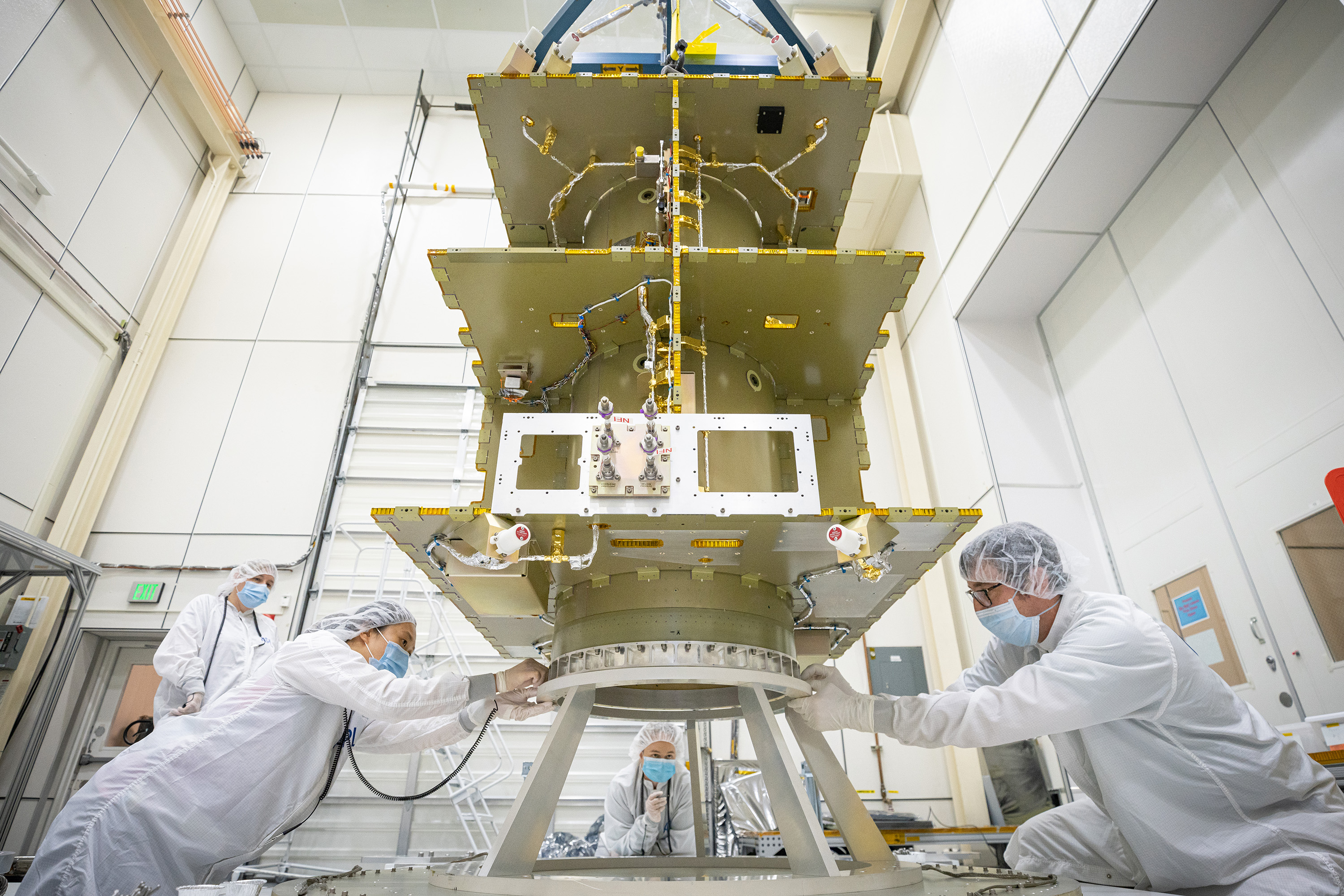
In a clean room in Building 23 at the Johns Hopkins University Applied Physics Laboratory (APL) in Laurel, Maryland, a spacecraft called DART was splayed open like a fractured, cubic egg. An instrument called a star tracker—which will, once DART is in deep space, ascertain which way is up—was mounted to the core, along with batteries and a variety of other sensors. The avionics system, DART’s central computer, was prominently attached to square, precision-machined panels that will form the sides, once the spacecraft is folded up. Wires ran from the computer to the radiosystem that DART will use to communicate with Earth. Gyroscopes and antennas were exposed. In a room next door, an experimental thruster system called NEXT-C was waiting its turn. Great bundles of thick tendrils wrapped in silver insulation hung down from the spacecraft and ran along the floor to the control room, where they connected to a towering battery of testbed computers operated by four engineers.
A clock over one of the computers read, “Days to DART Launch: 350:08:33.”
DART—the Double Asteroid Redirection Test—is designed to crash into an asteroid called Dimorphos. The impact will change Dimorphos’s speed by about one millimeter per second, or one five-hundredth of a mile per hour. Though Dimorphos is not about to collide with Earth, DART is intended to demonstrate the ability to deflect an asteroid like it that is headed our way, should one ever be discovered.
Since a Soviet probe called Luna 1 became the first spacecraft to escape Earth’s orbit on January 2, 1959, humanity has sent about 250 probes into the solar system. DART is unique among them. It is the first that sets out not to study the solar system, but to change it.
By 1980, astronomers had determined the orbits of about 10,000 asteroids, including 51 “near-Earth” asteroids (along with 44 near-Earth comets). Today, the numbers have swollen: the Minor Planet Center keeps track of about 800,000 asteroids in total, of which almost 24,000 have orbits that take them close to Earth. The vast majority of these have been discovered since 1998, when Congress gave NASA 10 years to identify every near-Earth object larger than one kilometer (0.6 miles) in diameter. Thanks to statistical analyses, astronomers believe they’ve found about 95% of the big near-Earth asteroids, the kind that would destroy civilization were they to hit our planet.
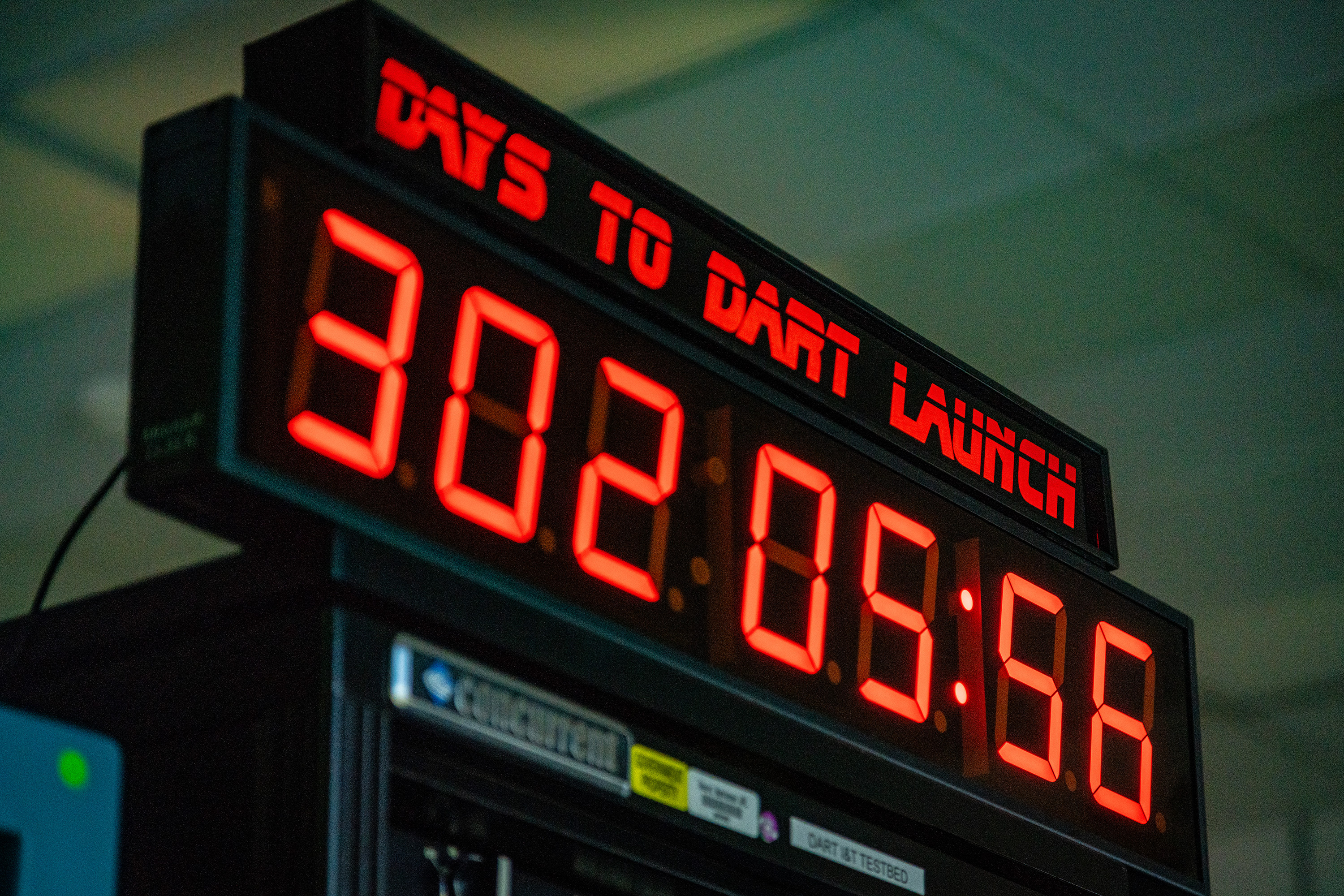
Earth moves the distance of its diameter every seven minutes. If the arrival time of an incoming object can be changed by more than about 10 minutes, it will miss us. (The details, of course, depend on the particular trajectory; the extra three minutes are to account for the effect of Earth’s gravitational pull.)
Didymos is about a half-mile across. Dimorphos is about 500 feet in diameter—about the size of a small sports stadium. Nobody yet knows what it looks like, because it is too small and far away for detailed observations from telescopes on or near Earth. The two asteroids are about a half-mile apart; Dimorphos orbits the larger asteroid at a speed slower than a person’s walk.
In 2005, Congress gave NASA new orders to catalogue all the near-Earth objects over 140 meters (460 feet) in diameter—objects whose impact would be catastrophic rather than apocalyptic. That work remains ongoing, and in 2016, NASA established the Planetary Defense Coordination Office to coordinate the myriad American and international agencies that would be mobilized if a destructive object were discovered heading our way. DART is the group’s first mission.
“We don’t have to be victims of the cosmos,” says Lindley Johnson, who heads the office. “If we are faced with that situation, we don’t want the first real-world use of asteroid deflection to be a must-succeed kind of thing.” DART’s aims are twofold: to prove that a spacecraft can successfully hit an asteroid, and to measure the effects of the collision.
Earlier proposals envisioned using two vehicles: one to do the colliding, and another, sent in advance, to watch the collision and measure its effects. It seemed like the only option because with an asteroid traveling at 30 kilometers per second, the millimeter-per-second change in speed caused by a collision would be very difficult to measure using telescopes based on or near Earth. But this was expensive: up to $1 billion.
Then, in early 2011, Andy Cheng, the chief scientist studying planetary defense at the Applied Physics Laboratory, had an epiphany. Rather than sending two spacecraft, his plan would send a single craft to crash into a small asteroid orbiting a larger one. Astronomers could then use a clever trick to measure the force of the blow.
“Every 12 hours, it goes around and around, always the same. What we're doing with DART is whacking the clock."
This simpler mission would cost only about $250 million—a relative bargain. The change was crucial in getting NASA to approve DART. In the end the Italian Space Agency contributed a shoebox-sized spacecraft called LICIACube to piggyback on DART, which will help with observations without greatly increasing the cost.
Cheng’s target, Dimorphos, was discovered in 2003 orbiting a larger asteroid. After the discovery, the larger body was named Didymos, the Greek word for twin. Its moon was given its name in 2020. As seen from Earth, its orbit sometimes passes in front of and behind Didymos, partly blocking out the larger asteroid on each revolution. Using ground-based telescopes, “you can make a very precise measurement of the orbit by looking at the dips in light,” says Cheng. A similar technique is used to identify exoplanets orbiting distant stars.
“The orbit of Dimorphos around Didymos is just like a ticking clock,” says Tom Statler, the DART mission’s program scientist at NASA headquarters. “Every 12 hours, it goes around and around, always the same. What we’re doing with DART is whacking the clock.” All astronomers have to do is measure how fast the clock ticks before impact, and then measure it again afterward. They expect the orbital period to change by about 10 minutes, or a bit over 1%.
This is enough information to allow them to estimate the figure they care about most: something called the momentum transfer efficiency, typically referred to by the Greek letter β. As the name implies, it’s a measure of how much of the spacecraft’s momentum is transferred to the asteroid (as opposed to, say, knocking chips of rock off it). The bigger β is, the more effective DART will have been in changing Dimorphos’s course.
Ascertaining β is important because to protect against asteroid impacts, we need to be able to predict how much one will budge when a spacecraft hits it. As Cheng and coauthors wrote in a 2020 paper, “The determination of β from DART measurements and modeling is a critically important planetary defense science objective.”
A few assumptions will go into the DART team’s computation of β. Roughly speaking, they will estimate Dimorphos’s size by analyzing pictures DART and LICIACube will take. That number, combined with an educated guess at the asteroid’s density, gives them an estimate for its mass. That number, combined with observations of the change in orbital period, lets them estimate β. (There is, yes, a lot of estimation involved.)
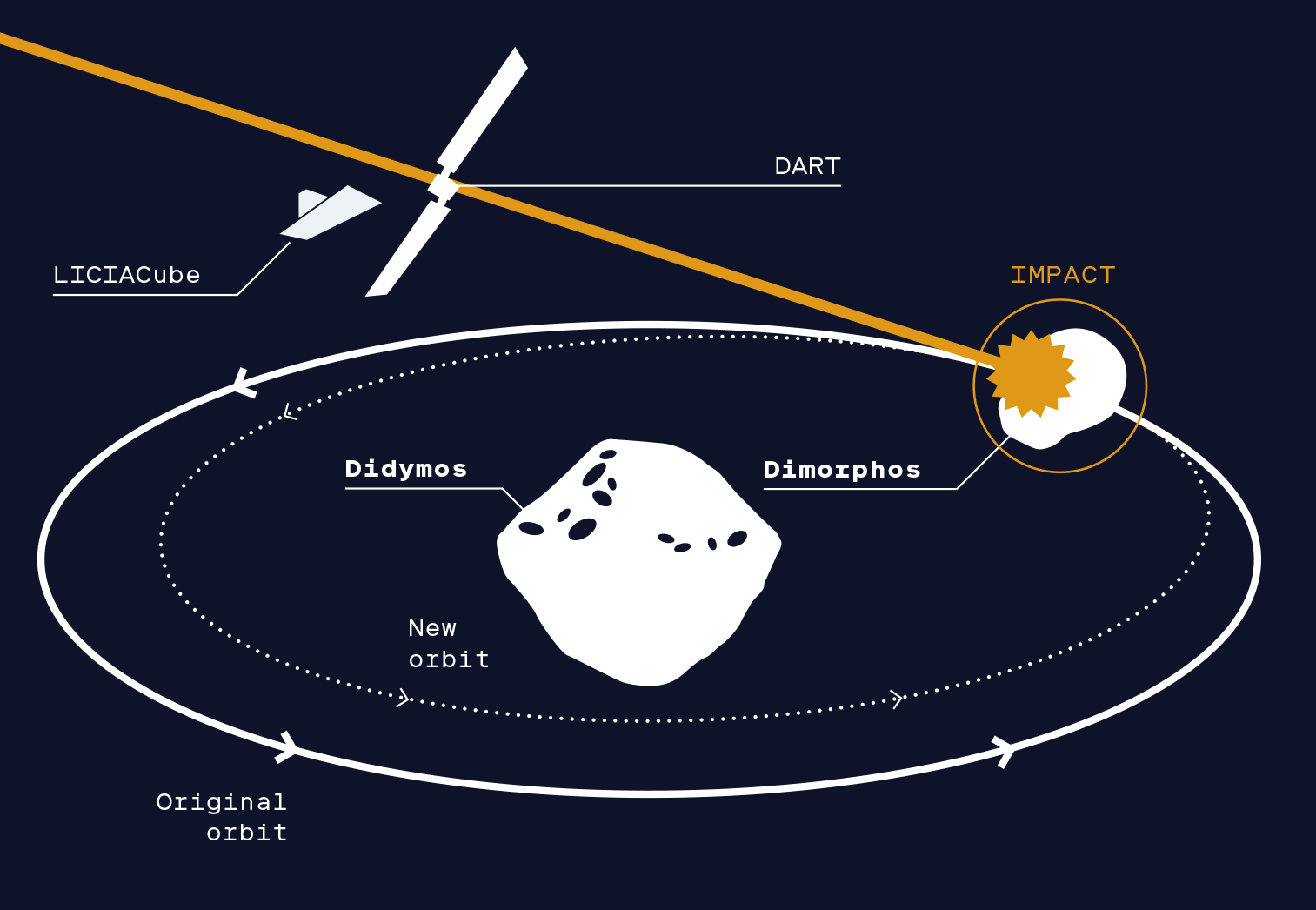
None of this, however, will tell astronomers why β took that particular value for the DART-Dimorphos collision. Asteroids are diverse in size and composition. Not much is known about their internal structure. Nobody knows for sure if DART will make a large crater or a small one. “We expect those factors to be dependent on the topography of where DART hits,” says Andy Rivkin, who leads the DART science team with Cheng.
In other words: Will the spacecraft hit a hillside or flat ground? Will there be boulders? Hard or soft rock? Gravel? Dirt? And as a result, how much ejecta will DART create? Which direction will that ejecta go, and how fast? Ejecta flying off in one direction gives the asteroid a kick in the opposite direction, so the answer affects the ultimate value of β.
The team plans to compare the data DART gathers with computer simulations of similar impacts. This will enable them to improve their models, allowing them to better calculate what kind of projectile it would take to deflect a future asteroid headed for Earth.
To build a spacecraft is to test a spacecraft. Getting to space is expensive; targeting a distant asteroid even more so. Things have to work the first time.
On an August day when I visited APL, Rosanna Smith, DART’s propulsion test lead, sat in the control room overseeing tests of the spacecraft’s hydrazine thrusters. Every component had already been tested—many times—individually. Now they were being tested again, as parts of a whole. DART was plugged into testbed computers that fed it data, making those components behave as though it were in space. The thrusters weren’t firing, but the spacecraft avionics responded as though they had. If an anomaly was detected, Smith explained, the engineers would stop to assess the probe. They might suit up and enter the clean room, attach an oscilloscope to the spacecraft, and see what was going on.
The goal was to get data on DART’s baseline performance. In the weeks to come, engineers were planning on subjecting the spacecraft to vibration tests: shaking it violently, physically approximating the stresses of launch and flight maneuvers, to see what, if anything, broke. They planned to put the spacecraft in a thermal vacuum chamber to simulate space, running it through hot and cold cycles. After each activity, they would perform the day’s tests over again, comparing the results with the baseline to see what did and did not change.
Ordinarily there might be a dozen people in the room running tests. But, like much else, DART’s assembly procedures have changed in response to the pandemic. APL has installed cameras throughout the facility. Those working from home can dial in to see what is happening. Their voices emerged from overhead speakers, and the engineers in the room responded casually, as though talking to ghosts.
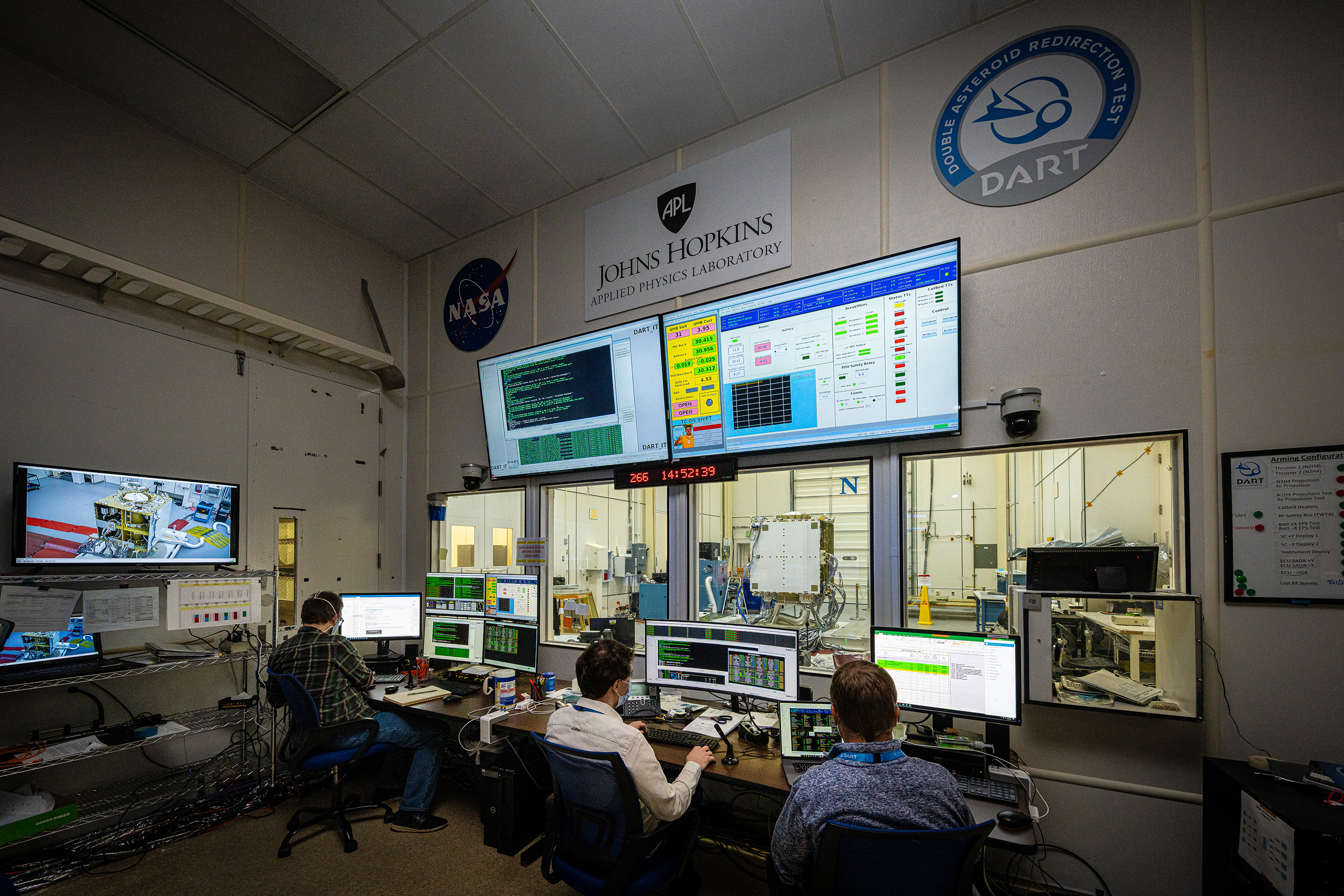
The journey from Earth to Didymos takes 14 months. DART will launch on a Falcon 9 rocket from Vandenberg Air Force Base on the coast of California, 130 miles northwest of Los Angeles. The spacecraft will take off to the south, and will circle the sun once before meeting the asteroids a few weeks after their closest approach to Earth, when Didymos and Dimorphos will be about 6.8 million miles away, about 30 times farther than the moon. The trajectory was designed to minimize the energy required to launch DART, and to time the impact for a close approach so that Earth-based telescopes can get their best possible look at the collision.
But first, DART has to find Didymos. Thirty days before impact, the spacecraft will begin collecting optical navigation images while it approaches the twin asteroids at almost 15,000 miles per hour. Astronomers don’t know the asteroids’ orbits to the precision necessary for a pre-programmed impact, and they still won’t when an onboard system called SMART Nav takes over. The mission plan calls for DART to hit no more than 50 feet off the planned target point, but by then the uncertainty about Didymos’s orbit will still be in the thousands of feet, and for the much smaller Dimorphos, it will be even bigger.
Four hours out, “we turn on SMART Nav, and it identifies Didymos and starts searching for Dimorphos, which we are trying to hit,” says Elena Adams, the DART mission’s chief engineer. There is radiation in space and noise in the detector, so the algorithms compare pixels in its field of view. An hour before impact, the software should pinpoint Dimorphos. “After it figures out the pixel that it wants, and that it’s in the right location, and that it makes sense, that’s when it switches from targeting the main asteroid to targeting its moon,” she adds.
Even if astronomers knew the position of Dimorphos with total accuracy, DART could not be pre-programmed to execute the required maneuver with enough precision to hit it. No thrusters are ever perfectly aligned, and no thruster performance is ever perfectly modeled. For every maneuver, a spacecraft needs follow-up correction maneuvers to account for deviations. SMART Nav does that autonomously. Moreover, DART will be using its thrusters to stay pointed in the right direction; this will change its trajectory by several feet. All such deviations will be continuously evaluated and corrected by SMART Nav in the final hours before impact. For typical spacecraft maneuvers executed by humans, in comparison, it usually takes hours or days to compute and execute them, and then to assess performance to design a correction. While making trajectory adjustments, SMART Nav keeps the spacecraft solar arrays pointed at the sun and the high-gain antenna pointed at Earth, sending back images of Didymos and Dimorphos about every two seconds. As the spacecraft approaches the asteroid, the hydrazine thrusters will frequently fire to keep the target within its camera’s narrow field of view.
SMART Nav will stop executing maneuvers about two minutes before impact, and the spacecraft will glide into the asteroid. “We achieve the required resolution of the impact site at about 20 seconds before impact and send the last image to Earth within the last seven seconds of impact,” says Adams. “And then—boom!”
Kinetic impactors like DART aren’t the only way to divert an incoming asteroid. NASA has contemplated detonating a nuclear bomb near an asteroid to deflect it. This releases a lot more energy to push the asteroid away but risks fragmenting it into a lot of smaller projectiles with unpredictable trajectories; some might still hit Earth. Other options include tugs, which would mate to an asteroid and push it off course with slow, steady thrust, or “gravity tractors,” spacecraft that would fly near an asteroid and, over the span of years or even decades, slowly pull it off its collision course by the force of their own gravity.
Both of these alternatives are more technically complicated than a kinetic impactor like DART. But DART is also testing technologies that could be applied to subsequent spacecraft.
For example, it will demonstrate the new ion thruster, NEXT-C. This isn’t necessary for DART’s mission, which will rely primarily on conventional chemical rockets. But ion thrusters, which use electricity to generate momentum, are much more efficient than their chemical counterparts. With a few hundred pounds of propellant they can accomplish what would take tens of thousands of pounds of chemical fuel like hydrazine. Only two spacecraft—Deep Space One and Dawn—have used ion thrusters in deep space, and NEXT-C is about three times more powerful than the ones on those missions.
To generate the electricity to power NEXT-C, DART will also use a new unrollable solar array that is lighter than conventional folding solar panels. By giving would-be planetary defenders more trajectories to choose from, sophisticated propulsion systems would allow impactors to hit incoming asteroids at higher speeds.
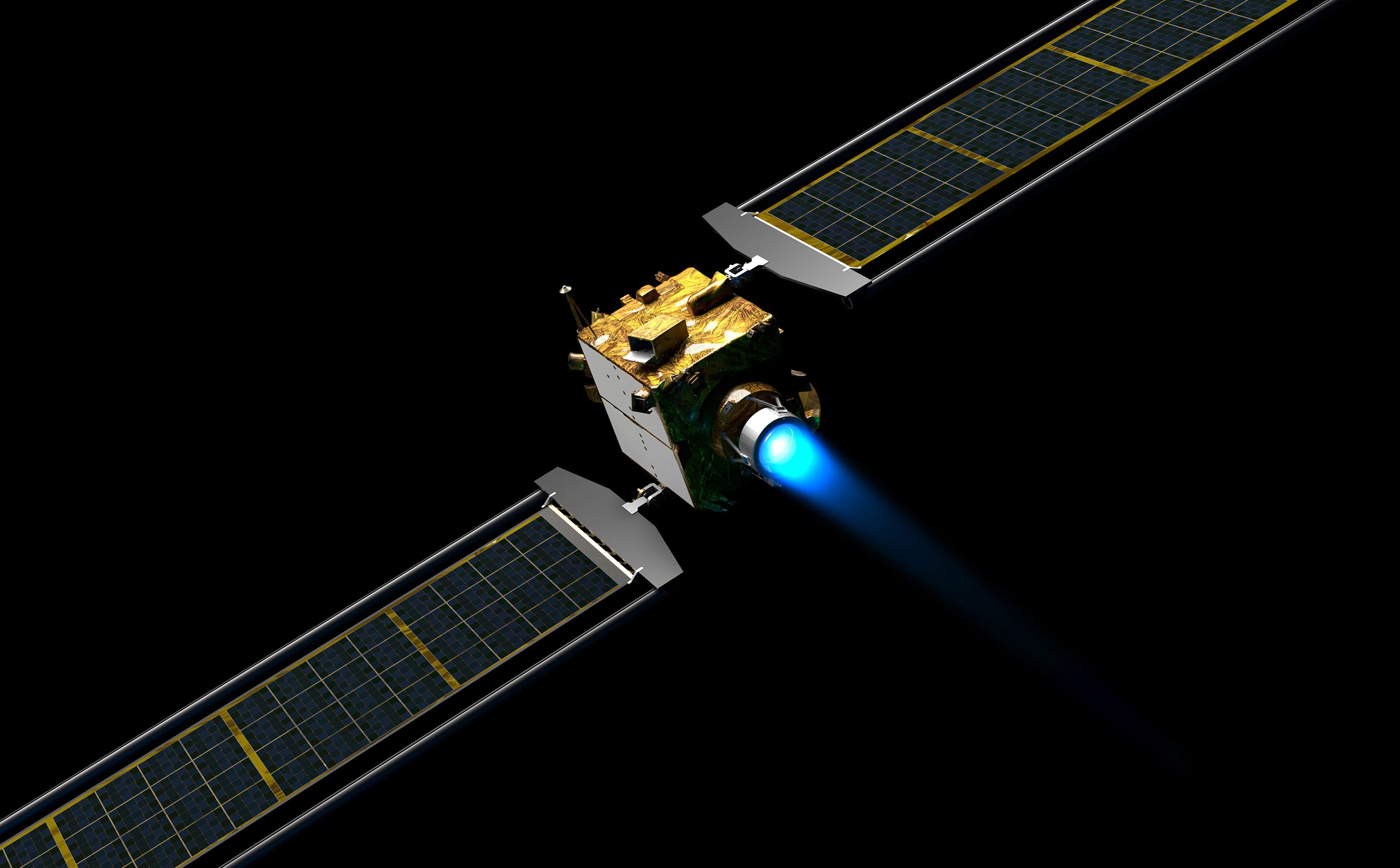
The sooner one can detect an asteroid—or other object, like a comet—that is headed toward Earth, the easier it will be to do something about it. Almost all the asteroids that might pose an extinction-level threat to life on Earth have already been found. These are enormous rocks several miles in diameter, and none of the known ones are threatening humanity anytime soon. (The Chicxulub impact that led to the extinction of the dinosaurs is thought to have involved an object on the order of 10 miles in diameter.) But astronomers have not found all the smaller, yet still dangerous, asteroids—like the meteor that exploded above Chelyabinsk, Russia, in 2013, with the force of a medium-size nuclear bomb. The Chelyabinsk object was about 20 meters in diameter; its strike broke windows for 200 square miles in the middle of winter in a highly populated area. Seventeen hundred people were injured, mostly by broken glass.
“Forty years ago, we did not know whether we might be wiped out by a giant killer asteroid a week from next Tuesday. That particular risk of ignorance has been retired,” says Statler, the DART program scientist. But objects smaller than 500 feet, about the size of Dimorphos, are difficult for current observatories, both terrestrial and satellite-based, to spot. (A 500-foot-diameter asteroid would hit with roughly the impact of the largest atomic bomb in history.) Right now, Statler says, maybe a quarter of the total number of potentially dangerous small objects have been identified. “If we don’t know where they are,” he says, “then we don’t have the capability to predict when an impact might occur and when we might have to do a deflection.”
The half-billion-dollar Near-Earth Object Surveillance Mission, an orbital infrared telescope being funded by the Planetary Defense Coordination Office, is set to launch later this decade, and it should help solve that problem. Because it observes in infrared wavelengths, it will have a greater ability than visible-light telescopes to look toward the sun. It will be able to detect objects that are bathed in sunlight, and thus not visible to ground-based telescopes. Additionally, the Vera Rubin observatory, a new telescope being built in Chile, will search for hazardous objects using a 3,200-megapixel camera, the biggest ever used in astronomy. “Our hope in another 20 years is to say, ‘Yep, we have retired that risk too, and we know which ones to keep an eye on,’” says Statler.
The sooner an incoming object is found, the less powerful a human-designed impactor needs to be to do the job. If a dangerous asteroid or comet is spotted at the 11th hour, it will take much more energy to change its course sufficiently.
LICIACube will separate from a compartment atop DART 10 days before impact and deploy its own little solar panels. As the small cubesat hangs back to watch, DART will hit Dimorphos.
The spacecraft will likely be shattered into very small pieces, some turned to powder. Most of its remnants will be blasted out again as ejecta when the crater is formed. It is possible that large structural members might survive, though they will be buried as deep as 10 feet into the asteroid. LICIACube will observe the plume of ejecta as it comes out, and will also photograph Dimorphos’s far side as it goes past. But it won’t have a means of slowing down—LICIACube will continue speeding past Dimorphos into the depths of space.
The European Space Agency is planning a mission called Hera, which is slated to launch in 2024 and to revisit Dimorphos in early 2027 to take more precise measurements of its mass, study its composition, and determine β with even greater precision. Hera will carry two cubesats of its own, and will travel around the Didymos-Dimorphos system for a planned three to six months, gathering far more data.
If all goes well, DART will leave Earth in late July 2021. On September 30, 2022, it will cease to exist—years of effort by hundreds of people transmuted into a nudge, the first of a new era.
Deep Dive
Space
The search for extraterrestrial life is targeting Jupiter’s icy moon Europa
NASA’s Europa Clipper mission will travel to one of Jupiter's largest moons to look for evidence of conditions that could support life.
How to safely watch and photograph the total solar eclipse
The solar eclipse this Monday, April 8, will be visible to millions. Here’s how to make the most of your experience.
How scientists are using quantum squeezing to push the limits of their sensors
Fuzziness may rule the quantum realm, but it can be manipulated to our advantage.
Stay connected
Get the latest updates from
MIT Technology Review
Discover special offers, top stories, upcoming events, and more.